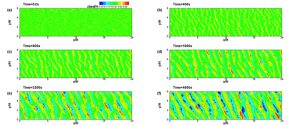From the Journal: Physics of Fluids
WASHINGTON, D.C., September 10, 2019 — If you’ve ever looked closely at a 3D sand or sediment dune within a river or coastal area, did you wonder how it formed?
After noticing how the construction of dams significantly alter the hydrodynamics of natural rivers and the resulting downstream riverbed evolution, a group of researchers at Tsinghua University in China decided to apply numerical simulations to help determine what’s at play in the relationship of sediment motion and flow conditions. They report their findings in Physics of Fluids, from AIP Publishing.

The group’s work was inspired in part by the impact of the Three Gorges Dam, which is a hydroelectric gravity dam that spans the Yangtze River. Since its construction in 2003, 11.7 kilometers (7.2 miles) of flat riverbed downstream within the Yangtze estuary was observed morphing into dune bedforms — features that form as a result of riverbed material being moved by fluid flow.
“This bed morphology evolution threatened navigation safety and the stability of river dikes, because the mechanism of sediment dune formation was unknown,” said Hongwei Fang, a professor at Tsinghua University.
The researchers set out to accurately simulate the fully turbulent flow near the riverbed and link it with the movement of sediment particles.
“We used large eddy simulation technology to obtain accurate near-bed instantaneous flow field, calculate the shear stresses acting on sediment particles and, finally, simulate the evolution of the riverbed,” said Fang.
By using visualization and power spectra analysis, the researchers were able to characterize the formation of sediment dunes into three distinct stages and clearly show the mechanism responsible for each.
“Interaction of near-bed flow and sediment particles has been rigorously investigated, but it still wasn’t exactly clear what was going on,” said Fang. “Partitioning it into three stages helped us clarify this process.”
“The initial defects that appear on the bed at the start of the process are closely tied to the instantaneous flow velocity right before the bed is destabilized,” he said. “We also discovered that defects with a high instantaneous flow velocity get washed away, while defects with low instantaneous velocity receive sediment deposits and grow in length and height. And, further, a constant wake zone forms downstream of micro sand waves, where sediment accumulates.”
As far as applications, this work will “help predict riverbed morphology evolution — how it forms and changes — within natural rivers,” Fang said. “And it will allow prevention of potential hazards, such as riverbank failure or ship stranding.”
Next, the group will explore river meandering, which poses a serious threat to rivers with dams.
“With our success simulating the evolution of riverbeds, we are confident of revealing the mechanism of river meandering, which is very important in river dike construction, lake river management and aquatic habitat protection,” Fang said.
###
For more information:
Larry Frum
media@aip.org
301-209-3090
Article Title
Numerical simulation of the production of three-dimensional sediment dunes
Authors
Y. Liu, H. Fang, L. Huang, and G. He
Author Affiliations
Tsinghua University
